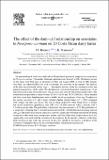| dc.contributor.author | Romero-Zúñiga, Juan José | |
| dc.contributor.author | Frankena, K. | |
| dc.date.accessioned | 2020-06-08T17:46:11Z | |
| dc.date.available | 2020-06-08T17:46:11Z | |
| dc.date.issued | 2003-03-31 | |
| dc.identifier.uri | http://hdl.handle.net/11056/17529 | |
| dc.description.abstract | An epidemiological study was conduced on 20 dairy herds previously diagnosed as seropositive
for Neospora caninum. The number of females per farm varies from 41 to 296. All females present
on the farms were bled once in the period of July and August 2000. A total of 3002 females
were bled. An indirect ELISA was used to determine the serostatus of the animals. The analysis
of the data was performed in four steps: (1) descriptive statistics about the serological status and
general characteristics of the cattle; (2) calculation of vertical and horizontal transmission; (3) an
univariate analysis and, (4) a multivariate logistic regression analysis with herd as random effect. The
within-herd seroprevalence varied between 25.0% (34/136) and 70.5% (203/288). Seven hundred
and forty-seven dam–daughter pairs were available, involving daughters of any age. Daughters in
the specific age-class of 2- and 3-years old had a higher seroprevalence (P < 0.01) compared
with younger and older age-classes. The risk of being seropositive when being born to a mother
that tested seropositive (prevalence ratio (PR)) was 2.8-fold increased which coincides with a
5.3-fold increased odds. The probability of horizontal infection amounts to 0.22. The probability of
a seropositive offspring due to vertical transmission was 0.64 (attributable fraction among exposed
(AFexp)). The multivariate logistic regression showed a significant 6.0-fold increased odds for being
seropositive when born from a seropositive mother. Also the within-herd seroprevalence level was
significantly associated with the serostatus of the daughters. In the specific conditions of the dairy
herds involved in this study, the serostatus of the cows should be not used as a predictor of the
serostatus of daughters due to the increased probability of horizontal transmission. | es_ES |
| dc.description.abstract | Se realizó un estudio epidemiológico en 20 rebaños lecheros previamente diagnosticados como seropositivos para Neospora caninum. El número de hembras por granja varía de 41 a 296. Todas las hembras presentes en las granjas fueron desangradas una vez en el período de julio y agosto de 2000. Un total de 3002 hembras fueron desangradas. Se usó un ELISA indirecto para determinar el estado serológico de los animales. El análisis de los datos se realizó en cuatro pasos: (1) estadísticas descriptivas sobre el estado serológico y las características generales del ganado; (2) cálculo de transmisión vertical y horizontal; (3) un análisis univariante y (4) un análisis de regresión logística multivariante con rebaño como efecto aleatorio. La seroprevalencia dentro del rebaño varió entre 25.0% (34/136) y 70.5% (203/288). Setecientas cuarenta y siete parejas madre-hija estaban disponibles, involucrando a hijas de cualquier edad. Las hijas en la clase de edad específica de 2 y 3 años tuvieron una mayor seroprevalencia (P <0.01) en comparación con las clases de edad más jóvenes y mayores. El riesgo de ser seropositivo al nacer de una madre que probó seropositivo (razón de prevalencia (PR)) aumentó 2.8 veces, lo que coincide con una probabilidad 5.3 veces mayor. La probabilidad de infección horizontal asciende a 0.22. La probabilidad de una descendencia seropositiva por transmisión vertical fue de 0.64 (fracción atribuible entre expuestos (AFexp)). La regresión logística multivariada mostró un aumento significativo de 6.0 veces en las probabilidades de ser seropositivo al nacer de una madre seropositiva. Además, el nivel de seroprevalencia dentro del rebaño se asoció significativamente con el estado serológico de las hijas. En las condiciones específicas de los rebaños lecheros involucrados en este estudio, el estado serológico de las vacas no debe usarse como un predictor del estado serológico de las hijas debido a la mayor probabilidad de transmisión horizontal. | es_ES |
| dc.language.iso | eng | es_ES |
| dc.publisher | Universidad Nacional, Costa Rica | es_ES |
| dc.rights | Acceso abierto | es_ES |
| dc.rights.uri | http://creativecommons.org/licenses/by-nc-nd/4.0/ | * |
| dc.source | Veterinary Parasitology 114 (2003) 159–171 | es_ES |
| dc.subject | GANADO BOVINO | es_ES |
| dc.subject | GANADO DE LECHE | es_ES |
| dc.subject | ELISA | es_ES |
| dc.subject | VIRUS | es_ES |
| dc.subject | EPIDEMIOLOGIA | es_ES |
| dc.subject | NEOSPORA CANINUM | es_ES |
| dc.subject | COSTA RICA | es_ES |
| dc.subject | VERTICAL AND HORIZONTAL TRANSMISSION | es_ES |
| dc.subject | SEROSTATUS | es_ES |
| dc.subject | DAIRY CATTLE | es_ES |
| dc.title | The effect of the dam–calf relationship on serostatus to Neospora caninum on 20 Costa Rican dairy farms | es_ES |
| dc.type | http://purl.org/coar/resource_type/c_6501 | es_ES |
| dc.description.procedence | Escuela de Medicina Veterinaria | es_ES |
| dc.identifier.doi | 10.1016/S0304-4017(03)00135-3 | |


